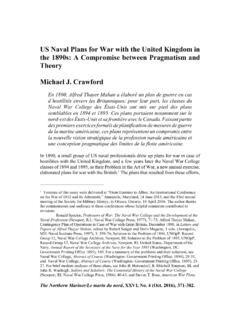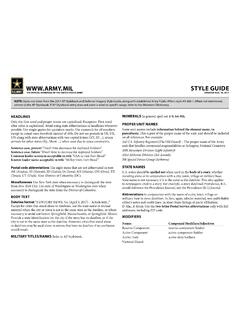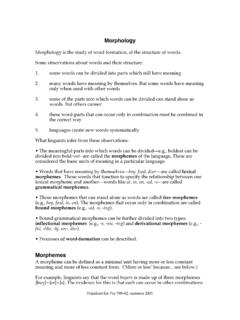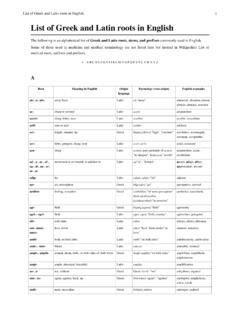Transcription of U.S. Navy Squadron Designations and Abbreviations
1 THE SYSTEM OF Squadron Designations wasestablished to help define part of naval aviation s orga-nizational structure and help identify the operationaland administrative functions of aviation within thefleet. Just as the Designations for ships, such as DD,CA, BB, etc., were used to define the duties of thespecific units and their alignment within the fleet orga-nization, so also were the Squadron designationsestablished to formulate the responsibilities and align-ment within naval aviation and the fleet structure. During naval aviation s early years there were bigquestion marks concerning naval aviation s ability tosucceed as a functional component of the fleet andwhether it would survive due to the limited capabili-ties of the aircraft. In official publications and refer-ences, such as the Daily Aviation News Bulletin of 1 October 1919, casual terms were used to describe oridentify various aircraft squadrons and units.
2 The casu-al terms were used because no specific fleet aviationorganizational structure for squadrons had been offi-cially established. Prior to 1919, naval aircraft, exclud-ing Marine Corps planes, were primarily assigned toshore stations. Therefore, in order to integrate aviationinto the fleet, it was necessary to develop a fleet orga-nization that included aviation units. The developmentof a system of Squadron Designations is discussed inChapter general terms, the Navy s system for designatingnaval aircraft squadrons has usually conformed to thefollowing loose classification structure: (1) Squadron Designations were based on specificletters used for indicating the missions foreach particular type of Squadron and itsassigned aircraft. As an example, a World WarII Squadron operating the F4U Corsair aircraftwould have been designated a fightingsquadron (VF).
3 The letter F, for fighting orfighter, was the key in identifying the type ofsquadron and was also used in the aircraft sdesignation. (2) Identification numbers were assigned to eachsquadron, such as VF-1. The number 1 sepa-rates Fighter Squadron 1 (VF-1) from FighterSquadron 10 (VF-10).There have been many variations to this basic sys-tem throughout naval aviation s history. Changes wereDICTIONARY OF AMERICAN NAVAL AVIATION SQUADRONS Volume Navy Squadron Designations and Abbreviationsalso made to the designation system when new planetypes were developed and new squadrons wereformed to carry out those new missions. There is nological sequence for the numerical designationassigned the various squadrons throughout most ofnaval aviation s history. The Marine Corps did estab-lish a logical sequence for their Squadron Designations ,however, there are variations to this system, Navy squadrons were established, disestablishedor redesignated, many of the same letters and num-bers were reused and assigned at a later date fornewly established or redesignated units, hence, thelineage of a Squadron cannot always be traced orlinked by using the same designation.
4 As an example,VF-1 from World War II has no direct relationship toVF-1 established in the 1970s. The rich tradition andheritage of the various squadrons in the Navy has notalways been carried over because of the break in con-tinuity between units. Once a Squadron is disestab-lished that ends its history. If a new Squadron is estab-lished using the same designation of a previoussquadron it does not have any direct relationship withthat unit. The reuse of many of the same letters andnumerical Designations adds considerable confusion tothe Squadron designation system. A new squadronmay carry on the traditions of a previous Squadron ,just as a ship that has been assigned the same namemore than once carries on the traditions of the pastships with the same name.
5 However, a Squadron , justlike a ship, can not claim a heritage or historical linkto the old unit with the same has been the major ingredient lackingin the Navy s Squadron designation system. As anexample, the use of Plane in Squadron designationswas not consistent during the 1920s. Sometimes thefull designation would be written differently, depend-ing on the Squadron s assignment to the Battle Fleet,Scouting Fleet, or Asiatic Fleet. A designation such asScouting Squadron and Scouting Plane Squadron ,which used the same abbreviation, VS, was listed inthe Navy Directoryas Scouting Squadron under theBattle Fleet and Scouting Plane Squadron under theScouting Fleet. The use of Plane in Squadron desig-nations was most likely designed to identify thesquadron as an aviation unit, vice a destroyersquadron.
6 This seems to be especially true during the537 Appendix 1---ps. 509-562 4/13/95 6:47 AM Page 537538 dictionary OF AMERICAN NAVAL AVIATION SQUADRONS Volume I1920s when aviation was first being integrated into thefleet organization and operations. The Navy Directory;Monthly Report, Status of Naval Aircraft;and the Bureauof Aeronautics, Weekly Newsletterall list Squadron desig-nations using Plane. The Chief of Naval Operations Naval Aeronautical Organization, published for eachFiscal Year, lists the Squadron Designations without using Plane in the designation. It is obvious there is no differ-ence between the squadrons with or without the use of Plane in the Squadron designation. The acronymremained the same, with or without the use of Plane inthe full Squadron designation. In the 1930s the squadrondesignations listed in all four sources identified aboveusually refer to the Squadron using its abbreviated desig-nation, such as VF Squadron 1 (VF-1) instead of FightingPlane Squadron 1.
7 In the 1940s the use of Plane in thefull Squadron designation is the late 1940s and early 1950s the VC squadrondesignation was used to identify a group of squadronswith several different missions but all assigned the VCdesignation. Missions for specific CompositeSquadrons (VC) included all-weather night, attack anddefense; air early warning; anti-submarine warfare;and photographic. The only identifying factor to sepa-rate the different types of Composite Squadrons wasthe numerical designation. In the late 1940s the singledigit numbers were for the Composite Night or Attackand Defense units, those numbers in the teens werefor Composite Air Warning squadrons, numbers in the20s and 30s were for Composite Anti-Submarine units,and the numbers in the 60s were for CompositePhotographic squadrons.
8 Besides the composite squadrons (VC), several patrolsquadrons (VP) had specific mission requirements thatwere different from its normal patrol and reconnais-sance duties. However, these squadrons still maintainedthe normal VP designation. In the late 1940s there weretwo VP squadrons with a primary mission of photo-graphic and one with an air early warning mission. VP-61 and VP-62 were the photographic squadrons andVP-51 was the air early warning Squadron . The special VC and VP designated units, were onthe cutting edge of technology, which eventually leadto the development of specialized Squadron designa-tions in the 1950s and 1960s. Squadrons such as VAW(Carrier Airborne Early Warning), VAQ (TacticalElectronic Warfare), and VQ (ElectronicCountermeasures or Air Reconnaissance) were theresult of technical developments in the late 1940s andearly use of an abbreivated Squadron designation withdifferent missions occurred in the early 1950s when theVJ designation was used for both photographicsquadrons and weather squadrons.
9 VJ-1 and 2 weredesignated Weather Squadrons or WeatherReconnaissance Squadrons. VJ-61 and 62 were designat-ed Photographic Squadrons. The missions were totallydifferent for these two types of squadrons but they useda common abbreivated Squadron are four factors that play a role in developingor changing Squadron Designations . They have beenaround since the introduction of aviation in the Navyand will continue to be the primary factors effectingsquadron Designations . The factors are:1. the duties or mission of a squadron2. technical advances in aircraft or equipment3. changes in tactics or development of new tactics4. changes in naval aviation or fleet organziationThe following is a list of various Squadron designa-tions used by the Navy since the early 1920s. It doesnot include Marine Corps Squadron Designations .
10 Thelist is in alphabetical order rather than in the chrono-logical order of Squadron development. The generaltime frame for when the designation was in use is list-ed with the Squadron designation. Further elaborationon the assignment of squadrons to other organizationsand their Designations such as: a battle group, carrierair wing, cruiser group, fleet air force, scouting fleet,Asiatic Fleet, naval district, reserves, , has not beenincluded in this list to prevent it from becoming to con-fusing or extensive. The only exception to this is forthe reserves. Reserve Squadron Designations , beginningin 1970, are included in this list. In 1970 the naval airreserve was reorganized and the Squadron structureand arrangement was aligned to mirror the squadrondesignation system in existence for active fleet NAVY Squadron Designations ANDABBREVIATIONSA cronymFull Squadron DesignationGeneral time-frame in useHAL or HA(L) Helicopter Attack Squadron Light1967-19721976-1988 HCHelicopter Combat Support Squadron 1965-presentHCSH elicopter Combat Support Special Squadron1988-presentHCTH elicopter Combat Support Training Squadron1974-1977 HMHelicopter Mine CountermeasuresSquadron1971-presentHSHel icopter Anti-Submarine Squadron1951-presentHSLH elicopter Anti-Submarine Squadron (Light)
















